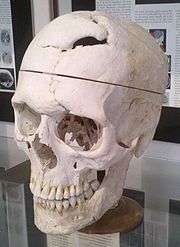Warren Anatomical Museum
The Warren Anatomical Museum, housed within Harvard Medical School's Countway Library of Medicine, was founded in 1847 by Harvard professor John Collins Warren,[1] whose personal collection of 160[2] unusual and instructive anatomical and pathological specimens now forms the nucleus of the museum's 15,000-item collection.[3] The Warren also has objects significant to medical history, such as the inhaler used during the first public demonstration of ether-assisted surgery in 1846 (on loan to the Massachusetts General Hospital since 1948[4]), and the skull of Phineas Gage, who survived a large iron bar being driven through his brain. The museum's first curator was J.B.S. Jackson.[5]

Closed until Spring of 2021
The museum gallery is closed for renovation until Spring of 2021, although the collection remains accessible to researchers by appointment. Normally a rotating subset of items, including Gage's skull and the tamping iron that passed through it, is on public display.
See also
References
- Wolly, Brian (January 1, 2010). "Highlights From the Warren Anatomical Museum". Smithsonian. Retrieved 22 October 2013.
- Jackson, J.B.S. (1870). A descriptive catalogue of the Warren Anatomical Museum. Boston: Williams. p. iv.
- "Warren Anatomical Museum". Harvard Medical School. Retrieved 13 September 2018.
- "The Ether Dome at Mass General". Massachusetts General Hospital. Retrieved 22 October 2013.
- Whitney, William F. (1911). The Warren Anatomical Museum of the Harvard Medical School and the arrangement of its collection. Boston: Harvard Medical School. p. 2. Retrieved 22 October 2013.
Sources
- Whitney, William F. (1910). Bulletin of the Warren Anatomical Museum. Boston: Harvard Medical School.
- Jackson, John B.S. (1870). – via Wikisource.
External links
- Warren Museum website
- Finding aid for Warren Anatomical Museum in Francis A. Countway Library of Medicine
- Medical Heritage Library Increases Warren Museum Accessibility
- Harvard Dental Museum